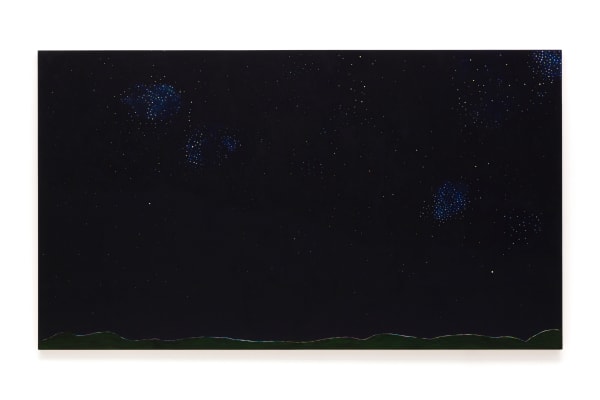Olha pro céu, meu amor Patricia Leite
Walter Benjamin
To throw worlds at the world
Caetano Veloso
To write a text entails a search for words and expressions that are able to elaborate an idea that only exists as an image in one’s mind. From where I write, I see the vast sky, as well as the line where it meets the sea and a plethora of plants and birds moving at their own pace under the same firmament. Perhaps this is indeed the perfect place to write about my emotions and impressions of Patrícia Leite’s works and to really grasp the possibility of appropriating the sky through the gaze. The landscape and life I see are woven into thought in the same way that thought is woven into the landscape and the mind, in an ongoing process.
Leite’s practice invites us to consider the relationship between light and all objects. Observing an innate life in all elements, the painter animates them or expresses their poetry. Olha pro céu, meu amor [Look at the sky, my love] follows Leite’s continued investigation of landscape, presenting a series of works themed on the sky. Here, the sky is multiplicity: it appears as the background and the figure, the landscape and the environment, the source and the event of light, the continent and the content…
The painting that lends its name to the exhibition, Look at the sky, my love, reveals a nocturnal landscape, in which an immense starlit sky takes up almost the entire painted surface, occupying and expanding the surrounding space. Underneath, at the bottom of the canvas, we see a fine iridescent line, timidly shining, separating the range of green hills from the blue-ish dark mass behind. This subtle line confronts the density of the dark tones and interplays with the stars shining above: splattered points of light permeate the surface like small gaps to find a passage to the other side.
Leite’s painting often challenges the contrast between abstraction and figuration. Her works emerge from the overlay of colours. Mountains, stars, rays, cracks and drops are formed from the lines and dots between the several coats of paint. Explosion I,Explosion II and Rain were based on photographs of exploding fireworks. The delirious drops and rays of light are optically confusing; if you rest your eyes on them for some time, abstraction prevails. As large-scale paintings (all 1,60 m high and up to 4 m long), they expand on the experience of looking at the sky to transform it into an experience of looking around you, of being surrounded by the sky.
When facing a new image, we should not only consider the history it documents but also the memory it activates and the elements of affection and absence that it triggers. During her three-month residency in Brussels (from December 2016 to February 2017), Leite’s studio overlooked the Notre Dame du Sablon Cathedral – an impressive 15th century gothic jewel. This was the first time the artist spent an extended period of time away from Brazil. This change of context, during the European winter, inspired a longing to return to her affectionate memories, familiar themes and places. As a consequence, Leite worked with images of 18th century churches from her birthplace of Minas Gerais, churches that are prevalent in her (and the Brazilian) vernacular. Nossa Senhora dos Prazeres and Ó are the result of this creative drift.
According to the artist, her production is almost entirely derived from her “sketchbook”: a collection of photographs she took of places she visited and situations she experienced. They work as an illustrated diary providing a study of forms and colours. Ó – a stained-glass project for the gallery’s three large windows – was created from a photograph of the church Nossa Senhora do Ó in Sabará, Minas Gerais. The small 18th century church – which displays a rich and complex array of panel paintings – is an important reference for the artist, one which she knows intimately. The façade, nonetheless, is simple, and not very different from many other churches in rural Minas Gerais. In Leite’s stained glass, we see a church surrounded by green mountains below a sky of intense light blue, a typical representation of the local landscape. As light filters through the stained-glass, this Brazilian context is cast over Brussels’ own landscape, the view of the Sablon cathedral just a few metres from the window. The glass not only works as a membrane between the outside and the inside but also as a connection between two distinct worlds with two different histories.
Look at the sky, my love refers to the initial verse of a song written by Luiz Gonzaga, a beloved late musician from the state of Pernambuco, whose popular music from the Northeast became a fundamental cultural reference in Brazil. Olha pro céu [Look at the sky] is a song about love during the Saint John festivities, a nationwide celebration that takes place in June. Using this title, Leite reveals once again her connection to Brazilian popular music and culture, which define the themes of her work. The choice of materials, such as stained-glass, tapestry or wooden bowls (gamelas) made by indigenous peoples, evidence of the value she places on artisanal traditions, using her practice to expand possibilities of experience, exchange and relationship.
The exhibition title is an invitation; an invitation to pause, to catch a glimpse of infinity, to recognize yourself in the world, in reality. To look at the sky, the multiplicity that surrounds us, which is the very rhythm of life. Perhaps it is only by looking up that we might begin to understand the imminent catastrophic consequences of the “falling sky,” which Davi Kopenawa Yanomami, a Brazilian indigenous shaman, famously forewarned us about.
Look at the sky, my love: it is essential.
– Camila Bechelany


















